<< Previous | Displaying results 101-125 of 1298 for "nazi germany" | Next >>
In Nazi usage, "euthanasia" referred to the systematic killing of those Germans whom the Nazis deemed "unworthy of life" because of alleged genetic diseases or defects. Beginning in the fall of 1939, gassing installations were established at Bernburg, Brandenburg, Grafeneck, Hadamar, Hartheim, and Sonnenstein. Patients were selected by doctors and transferred from clinics to one of these centralized gassing installations and killed. After public outrage forced an end to centralized killings, doctors…

Arrival of Jewish refugees from Germany. The Joint Distribution Committee (JDC) helped Jews leave Germany after the Nazi rise to power. France, 1936.
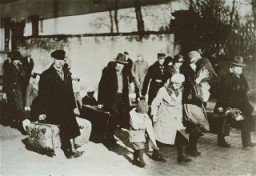
The Nazi regime issued more than 400 anti-Jewish decrees in its first six years of power. These policies gradually stripped Jews of their rights, livelihoods, and property. Altogether, the decrees functioned to sepa...
Adolf Hitler's foreign policy aimed at establishing a European empire for Germany through war. This policy required the rapid expansion of Germany's military capabilities. The Geneva Disarmament Conference, beginning in 1932, sought to avoid another European war by negotiating a reduction in armaments. Hitler repudiated this effort by withdrawing Germany from the conference in October 1933. At the same time, he rejected collective security in international affairs by withdrawing from the League of Nations.…
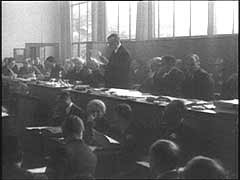
A Romani (Gypsy) victim of Nazi medical experiments to make seawater safe to drink. Dachau concentration camp, Germany, 1944.
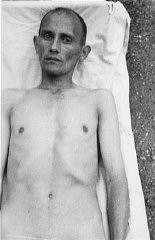
Poster promoting the Nazi monthly publication Neues Volk. Jews were not the only group excluded from the vision of the "national community." The Nazi regime also singled out people with intellectual and physical disabilities. In this poster, the caption reads: "This hereditarily ill person will cost our national community 60,000 Reichmarks over the course of his lifetime. Citizen, this is your money." This publication, put out by the Nazi Party's Race Office, emphasized the burden placed on society by…
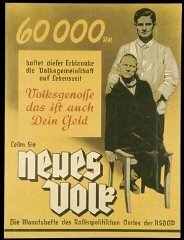
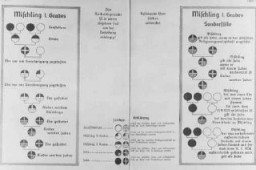
A victim of a Nazi medical experiment is immersed in icy water at the Dachau concentration camp. SS doctor Sigmund Rascher oversees the experiment. Germany, 1942.
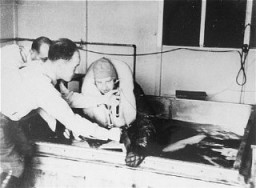
Nazi propaganda poster warning Germans about the dangers of east European "subhumans." Germany, date uncertain.
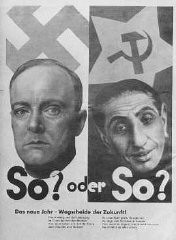
Members of the SA enter Danzig in 1939. Germany annexed most of western Poland and Danzig within weeks of the German invasion of Poland.
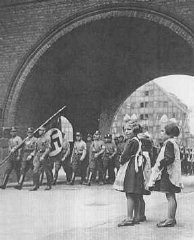
German spectators at a Nazi rally stand alongside a monument decorated with Nazi flags and a swastika emblem in Berlin. Germany, 1937.
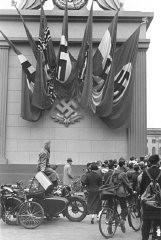
A march supporting the Nazi movement during an election campaign in 1932. Berlin, Germany, March 11, 1932.
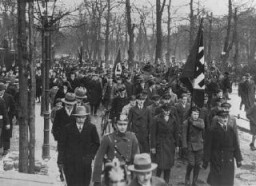
Nazi official Julius Streicher, founder of the antisemitic journal Der Stuermer (The Attacker) and organizer of the anti-Jewish boycott. Munich, Germany, ca. 1933.
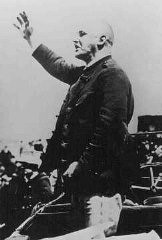
Exhibition of Nazi publications—carefully purged of antisemitic titles—on display during the Berlin Olympics. The poster shows countries in which Hitler's Mein Kampf had been translated into the native language. Berlin, Germany, August 1936.
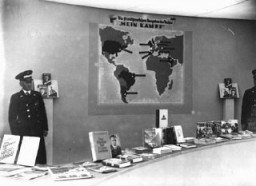
View of a bridge spanning a canal in Nuremberg. The houses and bridge are decorated with Nazi flags and banners. Photograph taken by Julien Bryan in Nuremberg, Germany, 1937.
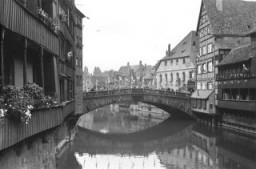
View animated map of key events toward the end of WWII in Europe as Allied troops encountered concentration camps, mass graves, and other sites of Nazi crimes.

Adolf Hitler became chancellor of Germany in January 1933. Soon thereafter, terror actions against opponents of Nazism began: Jews were a major target in these campaigns. Many Jews were subjected to public humiliation or arrest, and others were forced to quit their posts. Anti-Jewish measures climaxed with the April 1, 1933, boycott of Jewish-owned businesses. This footage depicts a Jewish anti-Nazi march in Chicago.
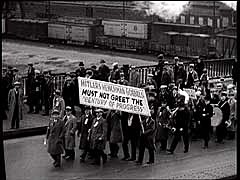
Psychiatric patients are evacuated to clinics where they will be murdered as part of the Nazi Euthanasia Program. Photo taken in Germany and dated circa 1942–1944. The term "euthanasia" usually refers to causing a painless death for a chronically or terminally ill individual who would otherwise suffer. In the Nazi context, however, "euthanasia" was a euphemistic or indirect term for a clandestine murder program that targeted individuals with physical and mental disabilities.
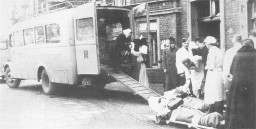
Nazi eugenics poster entitled "Feeble-mindedness in related families in four neighboring towns." This poster shows how "feeble-mindedness" and alcoholism are passed down from one couple to their four children and their families. The poster was part of a series entitled, "Erblehre und Rassenkunde" (Theory of Inheritance and Racial Hygiene), published by the Verlag für nationale Literatur (Publisher for National Literature), Stuttgart, Germany, ca. 1935.
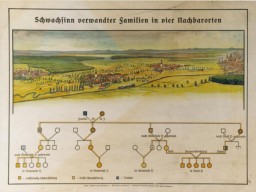
As Allied troops moved across Europe against Nazi Germany in 1944 and 1945, they encountered concentration camps, mass graves, and other sites of Nazi crimes. Learn more
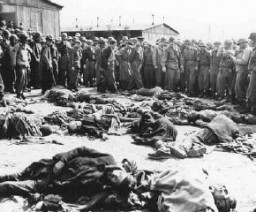
Hitler salutes the youth ranks at the Nazi Party Congress. Nuremberg, Germany, September, 1935.
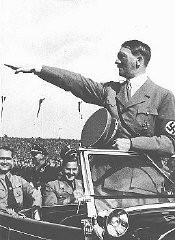
The film "The Nazi Plan" was shown as evidence at the International Military Tribunal in Nuremberg on December 11, 1945. It was compiled for the trial by Budd Schulberg and other US military personnel, under the supervision of Navy Commander James Donovan. The compilers used only German source material, including official newsreels. This footage titled "Hitler Predicts Annihilation of the Jewish Race in Europe if War Occurs" shows Hitler delivering a speech to the German parliament on January 30, 1939.
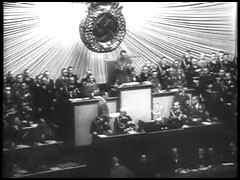
Nazi propaganda poster for 1932 elections, declaring Adolf Hitler to be the last hope of impoverished Germans.

This photograph shows the Kusserow family home in Bad Lippspringe and the tram tracks in front of it. The Kusserow family members were active Jehovah's Witnesses in their region. They distributed religious literature and taught Bible study classes in their home. Their house was conveniently situated for fellow Witnesses along the tram route connecting the cities of Paderborn and Detmold. For the first three years after the Nazis came to power, the Kusserows endured moderate persecution by local Gestapo…
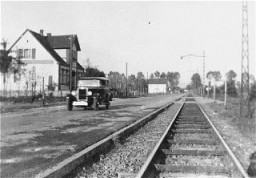
In 1933, the Nazis established the Hainichen labor camp in Sachsen, Germany. Learn more about the camp, its closing, and the prisoners.
We would like to thank Crown Family Philanthropies, Abe and Ida Cooper Foundation, the Claims Conference, EVZ, and BMF for supporting the ongoing work to create content and resources for the Holocaust Encyclopedia. View the list of donor acknowledgement.